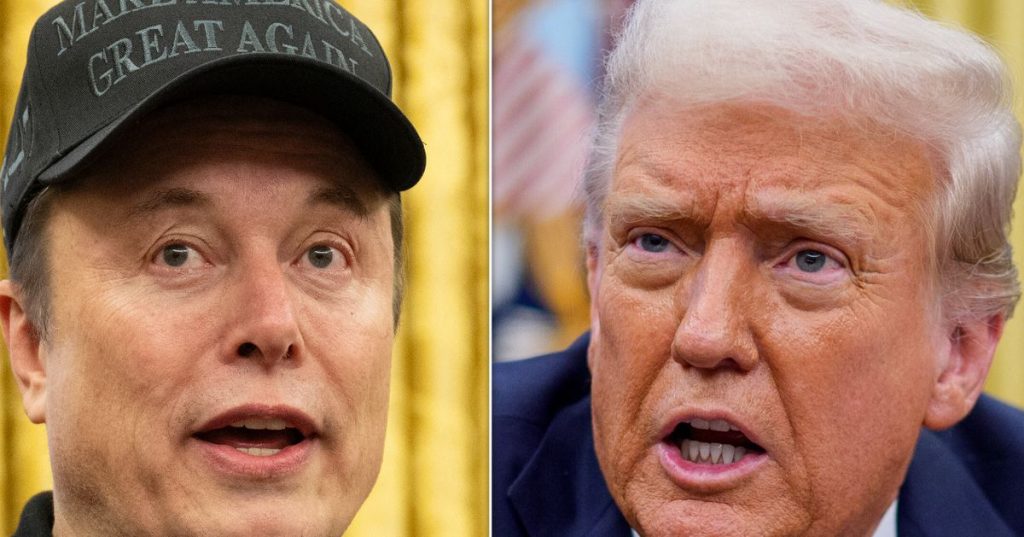President Donald Trump and Elon Musk, the billionaire CEO of Tesla and SpaceX, made headlines with a highly unusual joint press conference at the Oval Office. The event, which was both politically significant and deeply personal, sparked a flurry of reactions on social media and among body language experts. Trump, who signed an executive order expanding the power of Musk’s Department of Government Efficiency (DOGE), appeared to cede the spotlight to his billionaire ally, while Musk, accompanied by his 4-year-old son, delivered a mixed performance that raised eyebrows. The conference was a fascinating study in contrasts, with Trump seated at the Resolute Desk and Musk standing nearby, their differing postures and attire sending subtle but telling messages about power dynamics, trust, and the unusual nature of their partnership.
Body language experts were quick to analyze the visual cues of the event, particularly the seating arrangement and the way Trump and Musk positioned themselves relative to one another. Patti Wood, an expert in nonverbal communication, noted that Musk’s decision to stand while Trump sat suggested a power imbalance, with Musk holding the upper hand. Wood also highlighted the symbolism of Musk’s casual attire, including a “Make America Great Again” cap, which she interpreted as a sign that the billionaire felt no need to defer to the president. Trump’s formal attire, on the other hand, seemed to underscore his more traditional role as head of state. Karen Donaldson, another expert, offered a different perspective, arguing that Trump’s choice to remain seated while Musk spoke reflected a deliberate decision to convey trust and respect for his ally. She suggested that Trump saw no need to assert his authority over Musk, a dynamic that was both unusual and noteworthy.
Trump’s body language during the conference also drew significant attention, with many observers noting that he appeared disengaged and even bored as Musk spoke. Denise Dudley, a psychologist and body language expert, pointed out that Trump’s folded hands and vague facial expression suggested he was “fake listening,” a common nonverbal cue that signals disinterest or disengagement. Mark Bowden, another expert, observed that Trump’s brief, occasional smiles seemed more like moments of pride than genuine engagement, almost as if he were a “proud papa” watching Musk perform. However, Bowden also noted that Trump exhibited subtle signs of discomfort, such as avoiding eye contact and pursing his lips, when Musk made specific claims about Social Security fraud. These gestures, according to Bowden, could indicate that Trump either disagreed with Musk’s statements or was indifferent to the issue of ensuring Americans receive their Social Security benefits.
One of the most talked-about moments of the conference was the presence of Musk’s 4-year-old son, who was seen picking his nose and exhibiting typical preschooler behavior. The child’s antics quickly went viral on social media, with many critics accusing Musk of using his son as a distraction or even a prop. Even the child’s mother, Canadian pop star Grimes, weighed in, criticizing Musk for bringing their son to such a high-profile event. Body language experts were divided on the implications of the child’s presence. Mark Bowden suggested that the child served as a “symbol” of Trump’s power, implying that the president was so dominant that even the world’s richest man felt compelled to bring his child to the Oval Office. Bowden also argued that Musk used the child as a way to deflect attention, particularly during an awkward moment when he jokes about his son sticking his fingers in his ears to avoid a tough question about fraud in the Treasury Department.
Patti Wood, on the other hand, found the situation bizarre and off-putting, arguing that Musk’s attempt to juggle his parenting responsibilities while discussing major policy initiatives like slashing federal budgets came across as “clownish.” She also noted that Trump’s efforts to interact with the child fell flat, with the president appearing visibly annoyed by the distraction. Denise Dudley echoed this sentiment, observing that Trump’s body language conveyed irritation, particularly when Musk made a joke about the challenges of maintaining “gravitas” while his son spoke up. Dudley pointed out that Trump’s weak smile and tightly clasped hands suggested he was not pleased with the interruption, even as he tried to maintain a veneer of approval and solidarity.
The conference also raised questions about the broader implications of Trump and Musk’s alliance, particularly as it relates to the ongoing work of DOGE. With Musk leading the charge on a highly contentious initiative to downsize the federal workforce and root out waste, critics have raised concerns about transparency and accountability. The fact that neither Trump nor Musk provided specific details about the “billions and billions of dollars of waste, fraud, and abuse” they claim to have uncovered has only added to the skepticism. As the initiative continues to face legal challenges and public scrutiny, the dynamics between Trump and Musk will remain under close watch, both for what they reveal about the pair’s relationship and for what they suggest about the future of government accountability.
In the end, the joint press conference between Trump and Musk was a study in contrasts, blending elements of political theater, personal dynamics, and public spectacle. While the event offered few concrete details about the workings of DOGE or its goals, it provided a wealth of material for analysts to parse, from the subtle cues of body language to the larger symbolism of the occasion. As the partnership between Trump and Musk continues to evolve, it will be worth paying attention to both the substance of their collaboration and the optics of their interactions, as both are likely to play a significant role in shaping public perceptions of their efforts.
